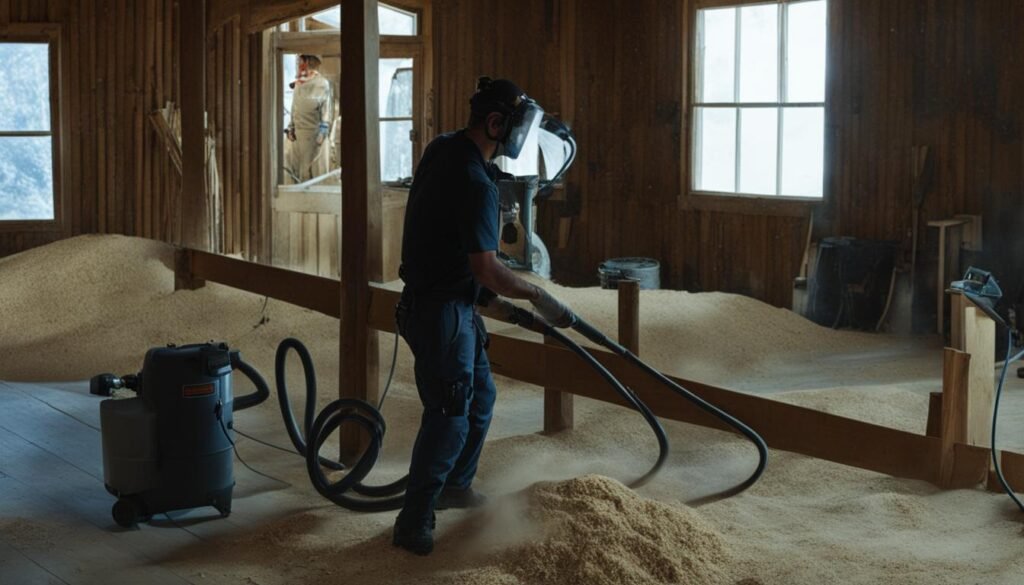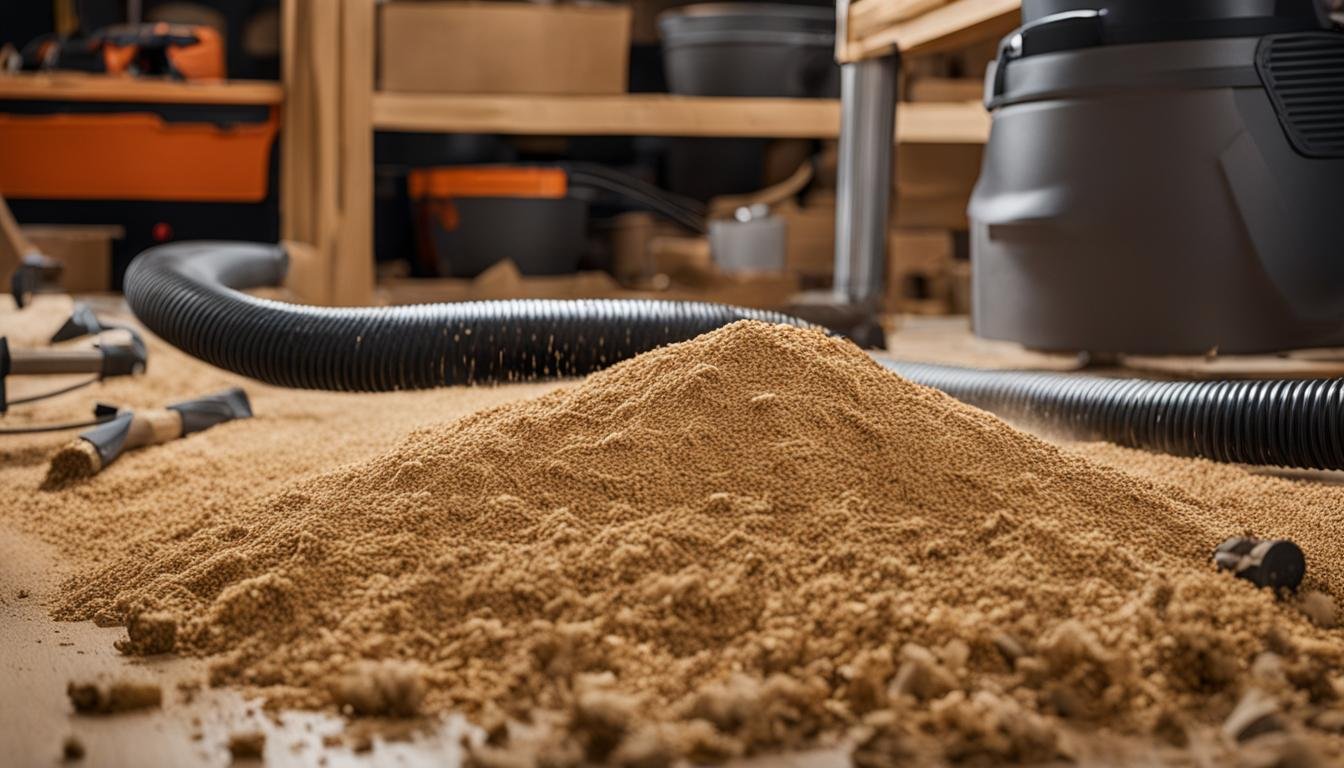The question of whether a vacuum cleaner can be used for dust extraction is a common one. Many people wonder if they can utilize their trusty vacuum cleaner to tackle the task of dust removal. While it’s tempting to repurpose a familiar tool for a new job, the answer isn’t as straightforward as it may seem.
According to online discussions on woodworking forums, there are varying opinions on the matter. Some users claim that using a dust collection system for vacuuming can be effective, while others advise against it. Let’s explore the pros and cons to help you make an informed decision.
Key Takeaways:
- Using a vacuum cleaner for dust extraction is a debated topic among woodworking enthusiasts.
- Some users find success in using a dust collection system for vacuuming, while others prefer separate systems for different tasks.
- Consider factors such as the type of dust, specific operations, and compliance with regulatory guidelines.
- Assess the risks and benefits before deciding whether a vacuum cleaner is suitable for your dust extraction needs.
- Ultimately, prioritize a clean and safe working environment when making your decision.
Differences Between Dust Collectors and Industrial Vacuums
When it comes to dust extraction, it’s important to understand the distinctions between industrial dust collectors and industrial vacuums. These two systems serve different purposes and have unique features that cater to specific needs. Let’s explore the differences between them:
Industrial Dust Collectors
Industrial dust collectors are designed to remove dust from the air, preventing it from settling on surfaces. They are particularly effective in capturing both nuisance and hazardous dust particles, ensuring a clean and safe working environment. Dust collectors come in various sizes and styles to accommodate different applications and airflow requirements.
Here are some key characteristics of industrial dust collectors:
- High volume, low-pressure system
- Designed to handle larger volumes of air and dust
- Gathers dust particles before they settle on surfaces
- Provides efficient dust removal from the air
Industrial Vacuums
On the other hand, industrial vacuums, also known as shop vacuums, are powerful tools used to clean industrial facilities. They are specifically designed to remove dust, debris, and other types of contaminants from various surfaces such as floors, walls, and machinery. Industrial vacuums operate on the principle of low volume, high pressure, making them effective in removing settled dust.
Here are some key characteristics of industrial vacuums:
- High-pressure suction for effective debris removal
- Focused on cleaning surfaces and removing settled dust
- Ideal for maintaining cleanliness in industrial settings
Choosing the Right System
When deciding between a dust collector and an industrial vacuum, it’s essential to consider factors such as facility size, dust type, and specific operations. Table 1 presents a comparison of these two systems:
| Dust Collector | Industrial Vacuum | |
|---|---|---|
| Main Function | Capturing dust from the air | Removing settled dust from surfaces |
| Operating Principle | High volume, low pressure | Low volume, high pressure |
| Application | Preventing dust settlement, maintaining air quality | Surface cleaning, debris removal |
| Capacity | Handles larger volumes of air and dust | Focuses on cleaning surfaces efficiently |
As seen in Table 1, the choice between a dust collector and an industrial vacuum depends on the specific requirements of your facility. It’s important to evaluate factors like the nature of the dust, the area to be cleaned, and the desired dust removal method to make an informed decision.
Now that we have a better understanding of the differences between dust collectors and industrial vacuums, we can explore compliance and best practices related to these systems in the next section.
Compliance and Best Practices
When it comes to maintaining a safe and clean facility, compliance with regulatory bodies like OSHA and NFPA is of utmost importance. Industrial dust collectors and vacuums play a crucial role in meeting these compliance requirements.
OSHA (Occupational Safety and Health Administration) has established permissible exposure limits (PELs) to control contact with hazardous substances, including dust and fumes. Facilities that produce or handle toxic dusts must ensure that exposure levels remain below these limits. One effective way to achieve this is by employing an industrial dust collector, which can effectively capture dust at its source and prevent its release into the air.
NFPA (National Fire Protection Association) outlines guidelines for facilities dealing with combustible dust. NFPA 652 specifically requires these facilities to perform a dust hazard analysis (DHA) and implement appropriate control measures. While dust collectors are commonly used for capturing dust at its source, vacuums are essential for removing settled dust from surfaces and preventing potential ignition.
It’s important for facility managers to carefully assess their specific requirements and choose the right tool for the job. Whether it’s using a vacuum cleaner for dust extraction, employing a dust collection system, or combining both, the goal is to ensure compliance, maintain a clean environment, and safeguard the health of employees.
Best Practices for Dust Extraction
- Regularly inspect and maintain dust collection systems and vacuums to ensure their optimal performance.
- Train employees on proper use and safety measures when operating dust extraction equipment.
- Follow manufacturer’s guidelines for filter replacement, cleaning, and maintenance.
- Implement a comprehensive cleaning schedule to address dust accumulation on surfaces and prevent its dispersal.
- Consider using HEPA filters to further enhance the efficiency of dust extraction systems.
“Proper dust extraction not only promotes a cleaner work environment but also helps mitigate potential health and safety risks for employees.” – John Smith, Health & Safety Expert
By adhering to compliance regulations and implementing best practices for dust extraction, facilities can create a safer and healthier environment for their workforce. Combining the appropriate technologies and operating procedures will not only enhance productivity but also contribute to long-term cost savings by reducing equipment downtime and minimizing dust-related maintenance issues.

Conclusion
In conclusion, the use of a vacuum cleaner for dust extraction is a topic that requires careful consideration. While some users have had success with using a dust collection system for vacuuming, it is important to assess the specific needs and requirements of the facility.
Factors such as the type of dust, the specific operations being performed, and compliance with regulatory guidelines should all be taken into account. It may be beneficial to use separate systems for different tasks, ensuring efficient and safe dust extraction.
Ultimately, the goal is to create a clean and safe working environment. By evaluating the risks and benefits associated with using a vacuum cleaner for dust extraction, facilities can make informed decisions that promote cleanliness, compliance, and employee well-being.
FAQ
Can I use a vacuum cleaner for dust extraction?
Yes, it is possible to use a vacuum cleaner for dust extraction. However, there are pros and cons to consider. Some users recommend using a separate dust collection system for certain tasks, while others claim that a dust collection system can be used as a vacuum cleaner with great success. It’s important to take proper precautions to minimize risks and ensure safe operation.
What are the differences between dust collectors and industrial vacuums?
Dust collectors and industrial vacuums are two different systems used for dust extraction. Dust collectors remove dust particles from the air and come in various sizes and styles, while industrial vacuums are designed to remove dust and debris from surfaces like floors and machinery. Dust collectors handle larger volumes of air and dust compared to vacuums and are often used to capture dust at its source, while vacuums are used to remove settled dust from surfaces.
How can I ensure compliance and best practices for dust extraction with a vacuum cleaner?
To ensure compliance, it’s important to choose the right tool for the job based on factors such as the type of dust and specific operations being performed. Compliance with regulatory bodies like OSHA and NFPA is crucial for maintaining a safe and clean facility. OSHA has established permissible exposure limits (PELs) to control occupational contact with hazards such as dust and fumes. NFPA 652 requires facilities dealing with combustible dust to perform a dust hazard analysis (DHA) and implement appropriate control measures. Choosing the correct system and following the appropriate guidelines will help maintain a clean and safe working environment.
What is the conclusion regarding using a vacuum cleaner for dust extraction?
The decision of whether to use a vacuum cleaner for dust extraction depends on various factors and considerations. While some users have reported success in using a dust collection system as a vacuum cleaner, others recommend using separate systems for different tasks. It is important to assess the risks and benefits, consider the type of dust and specific operations, and comply with regulatory guidelines. Ultimately, the decision should be based on the specific needs and requirements of the facility to ensure a clean and safe working environment.





Leave a Reply